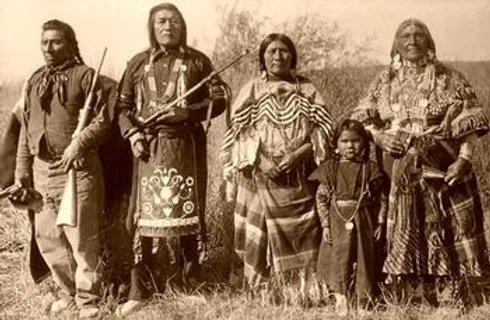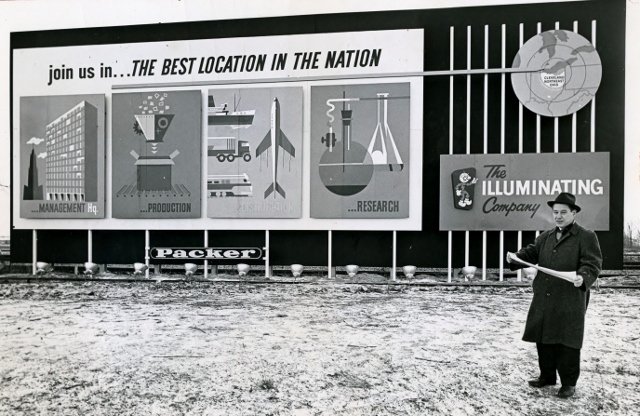
CLEVELAND
HISTORY
EARLY 1600s
NATIONAL LANDMARKS NAMED
Image sourced from AlTru Solution, LLC.
The history of Cleveland can be traced back to the banks of the Cuyahoga River feeding north and south into the shores of Lake Erie. The earliest known settlers here were Native American tribes including the Seneca, Mohawk, and Erie, which contributed to forming the first settlements in the region as well as naming the surrounding bodies of water. “Cuyahoga” is believed to be the Mohawk word for “crooked” and Lake Erie was named after the Erie tribe that inhabited the land. The influence of Native Americans in this territory, especially their naming of natural landmarks, laid a foundation for the future of regional pride. However, just like Cuyahoga, that future is long and winding.
1700s
WESTERN RESERVE & MOSES CLEAVELAND
Image sourced from Wikipedia.
In 1662, the newly established United States Government expanded west from Connecticut under royal charter. The first expansion became known as the Northwest Territory and consisted of what is now Ohio, Michigan, Indiana, Illinois, Wisconsin and parts of Minnesota. However, Connecticut did not relinquish what would become Northeast Ohio, until the land was sold to the Connecticut Land Co. in 1795. At this time, Northeast Ohio was known as New Connecticut and Connecticut Western Reserve.
Moses Cleaveland was a stakeholder in the Connecticut Land Co. and was the first to survey the land after purchase. In 1796, Cleaveland chose the current city location as the “capital” of the Western Reserve due to the economic advantages of being settled on the Cuyahoga River. The surveying party convinced Moses to name the settlement after himself after considering naming the region Cuyahoga due again to the importance of the river to this region. Cleaveland later used “Cuyahoga” for the name of the county in which the city is located. Although original maps show the spelling of both Cleaveland and Cleveland, “Cleveland” ultimately became the official name of the city. There is still speculation on the difference in spelling and why the letter “a” was eventually removed.
1800s
FOREST CITY
Around 1850, Cleveland received what was likely its first nickname: Forest City. Though there is some speculation as to why the name arose, most attribute the name to Cleveland’s mayor at the time, William Case. His interest in horticulture sprung a tree planting initiative, and the name has stuck ever since. Just take a quick look around Cleveland and many businesses still don the Forest City moniker.
1900s
THE FIFTH & SIXTH CITY
Image sourced from Mark Souther.
Cleveland’s growth through the turn of the 20th century was so monumental that the city earned more nicknames, including “Fifth City” and “Sixth City”. These names originated from the pride citizens felt in their growing city population. Between 1890 and 1970, Cleveland was in the top ten in the United States for largest city population. In 1910, Cleveland overtook Baltimore to become the sixth largest city and celebrated that fact at the Chamber of Commerce. Throughout the next decade, “Cleveland, Sixth City,” was constantly used in business communications, postcards, advertisements, and articles. By 1920, Cleveland achieved the mark of fifth highest city population and embraced the term “Fifth City.” Only New York, Chicago, Philadelphia, and Detroit had larger populations. Cleveland maintained this honor through the 1940s.
1940s-1970s
POST WWII
The Cleveland Electric Illuminating Co. launched the next wave of city promotion in 1944 with their campaign claiming Cleveland as “The Best Location in the Nation,” hoping to recruit businesses to Northeast Ohio during the post-war boom. The campaign boasted not only the availability of a skilled workforce in the region, but also the area's natural resources that could easily be transported by water, road, train, or air. The Illuminating Co.’s strategy went beyond the city and expanded through the suburbs. Unfortunately, that same expansion led to many families and businesses to move to the suburbs as well, leaving the city of Cleveland to experience dramatic economic decline.
Image sourced from Cleveland Historical.
1970s
MISTAKE ON THE LAKE
Image sourced from Cleveland.com.
By the start of 1970, Cleveland’s issues economically, environmentally, and politically led to a steep decline in the city’s image locally and nationally. A year after the 1969 Cuyahoga River Fire, Cleveland was dubbed the “Mistake on the Lake.” This environmental issue was overblown nationally, but created a stream of Cleveland jokes that shamed the city for years to come. The original fire in 1969 lasted 20 minutes and caused limited damage, but when Time Magazine published an article on the accident, they used a picture of a previous fire on the Cuyahoga River from 1952. The media attention thereafter depicted the city as a dirty, polluted place. As a result of that fire, the Clean Water Act of 1972 was passed by Congress. After years of jokes about the condition of the city, Clevelanders adopted a mentality of having thick skin. This was highlighted in the late 1970s by a local famous t-shirt printer known as “Daffy Dan.” Dan coined the slogan, “Cleveland: You’ve Got to Be Tough!” This phrase was seen all over the city leading into the 1980s.
1980s
AMERICA’S NORTH COAST/ “CLEVELAND IS A PLUM”
Image sourced from Case Western Reserve University.
After decades of defending itself nationally, the 1980s gave Cleveland a new opportunity to promote the unique aspects of the city. The nickname “America’s North Coast” was popularized in the early 1980s and it became the official tourism slogan soon after. The thought was to promote Cleveland as a port city bustling with business from all over the country. The campaign included a billboard near Cleveland Hopkins Airport that read “Welcome to America’s North Coast!” Local businesses and citizens embraced the nickname throughout the 1980s. In 1987, the newly developed Cleveland lakefront was dubbed “North Coast Harbor” after a naming contest in The Plain Dealer.
A few years earlier, however, The Plain Dealer had created their own slogan: “Cleveland is a Plum.” The idea played off the expression of something being plum or superior while also hinting towards New York’s branding as the “Big Apple.” The slogan was first presented to locals in May of 1981 at a Cleveland Indians vs. New York Yankees game where Mayor George Voinovich threw out the first pitch using a plum. This slogan remained in favor with Clevelanders until the mid 1980s.
LATE 1980s
THE ROCK ‘N’ ROLL CAPITAL OF THE WORLD
Image sourced from Axios Cleveland.
Although Cleveland supported the rise of rock ‘n’ roll in the 1940s, it did not become the rock ‘n’ roll capital of the world until it won the bid to build the Rock and Roll Hall of Fame and Museum in 1986. The city had already earned the same nickname in 1972 when a local WMMS radio personality, Billy Brass, attributed the naming of the genre to Leo Mintz and Alan Freed. Mintz owned Cleveland-based record store “Record Rendezvous” and rebranded rhythm and blues albums of the time to rock ‘n’ roll to calm local racial tension and present the genre to more audiences. Mintz persuaded Freed, a disc jockey in Akron, to play what they now called rock ‘n’ roll music on the radio. Freed helped champion the term and threw what became known as the first rock concert in 1952: The Moondog Coronation Ball at the Cleveland Arena.
LOCAL NICKNAMES OF THE 1990s-2010s
Image sourced from NBA.
Before the 1990s, most of Cleveland’s nicknames could be attributed to local boosters and organizations, but the 1990s and 2000s saw a transition to its citizens coining their own homegrown monikers. Some popular nicknames from this era include “216,” “CLE,” “The Land,” and “C-town.” The Land became popularized by Cleveland’s own Bone Thugs-N-Harmony. LeBron James also used “The Land” as a nickname for the city as well as a brand name for one of his city-based Nike sneakers. 216 is Cleveland’s area code, but also a popular name for the city in the hip hop community. Many local businesses adopted 216 in phrases like “Made in 216” and “Shop the 216.”
2010s-2020s
#THISISCLE
Image sourced from Pixels.
In the 2010s, a more authentic and local concentration took place when attempting to improve the city. Organizations began to seek opinions of locals rather than outsiders. Destination Cleveland and Positively Cleveland launched the “This is Cleveland” campaign in 2014 and is still in use today. The goal has been to boost local pride and promote Cleveland as a tourist destination for younger audiences. The operation includes an interactive website, the hashtag #ThisIsCLE on social media, and physical branding around the city with script Cleveland signs placed in areas with great photo opportunities.
2016-2024
BELIEVELAND: THE SPORTS COMEBACK
Image sourced from New York Times.
Pride in our city has always been tied to the sports teams that share the Cleveland name. In 2010, when star athlete and hometown hero LeBron James announced he was leaving Cleveland, the city felt defeated. In 2014, James returned to Cleveland with an open letter stating that “In Northeast Ohio, nothing is given. Everything is earned.”
James delivered on his promise to bring a championship to Cleveland when the 2016 Cleveland Cavaliers overcame a 3-1 series deficit to the Golden State Warriors to win the NBA Championship. The Cavaliers embodied the toughness of Cleveland, and Clevelanders embraced the pride they had in their team and city like never before.
“Believeland” was a popular nickname during this time that embodied Clevelanders’ perseverance and unrelenting hope through tough times much like the Cavaliers were able to show by coming back and winning a championship after the rest of the world counted them out. This team was able to attain the positive national attention the city had craved since their last championship in 1964, when the Browns won the NFL Championship Game.
SOURCES
Kuckelheim, Katie, “CLEVELAND NICKNAMES AND SLOGANS,” Encyclopedia of Cleveland History Case Western Reserve, updated Feb 27, 2023
"Best Location in The Nation..?" Cleveland Call and Post (1934-1962), Dec 19, 1953.
Dawson, Lois. "The Mistake on the Lake?" Call and Post (1962-1982), May 2, 1964.
Hatcher, Harlan. The Western Reserve: The Story of New Connecticut in Ohio. Kent, Ohio: Kent State University Press in cooperation with the Western Reserve Historical Society, 1991.
May, Jon D. “Erie.” The Encyclopedia of Oklahoma History and Culture. Accessed on April 18, 2022.
"Mets Campaign for Stokes." Call and Post (1962-1982), Nov 04, 1967, City edition.
Miller, Carol Poh and Robbert A. Wheeler. Cleveland: A Concise History, 1796-1996, Second Edition. Bloomington: Indiana University Press, 1997.
Ohio General Assembly. An Act to incorporate the village of Cleveland in the county of Cuyahoga. Ohio History Connection, SAS 577 Box 4. Columbus, Ohio, 23 December 1814.
Rose, William Ganson. Cleveland: The Making of a City. Kent, Ohio: The Kent State University Press, 1990.
Souther, J. Mark. Believing in Cleveland: Managing Decline in the Best Location in the Nation. Philadelphia: Temple University Press, 2017.
Souther, J. Mark. “‘The Best Things in Life Are Here’ in ‘The Mistake on the Lake’: Narratives of Decline and Renewal in Cleveland.” JOURNAL OF URBAN HISTORY 41, no. 6 (November 1, 2015): 1091–1117.
“Sustainable Cleveland.” Sustainable Cleveland. Accessed on April 18, 2022.











